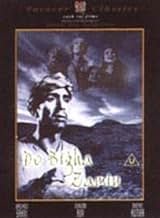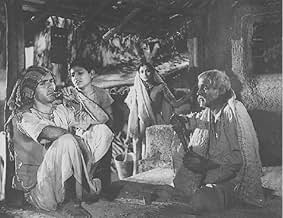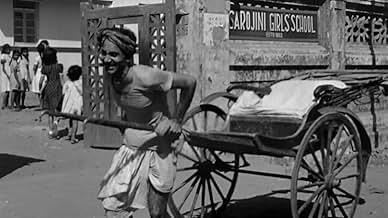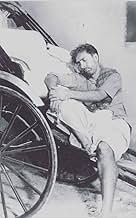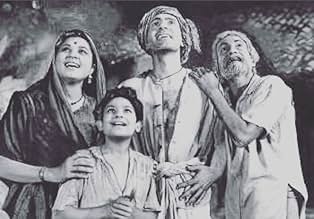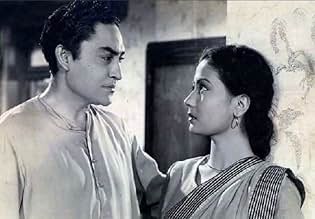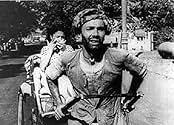IMDb रेटिंग
8.3/10
2.4 हज़ार
आपकी रेटिंग
अपना कर्ज चुकाने और अपनी जमीन बचाने के लिए पर्याप्त पैसा कमाने की उम्मीद में, एक गरीब किसान कलकत्ता में रिक्शा खींचने वाला बन जाता है और कई कठिनाइयों का सामना करता है.अपना कर्ज चुकाने और अपनी जमीन बचाने के लिए पर्याप्त पैसा कमाने की उम्मीद में, एक गरीब किसान कलकत्ता में रिक्शा खींचने वाला बन जाता है और कई कठिनाइयों का सामना करता है.अपना कर्ज चुकाने और अपनी जमीन बचाने के लिए पर्याप्त पैसा कमाने की उम्मीद में, एक गरीब किसान कलकत्ता में रिक्शा खींचने वाला बन जाता है और कई कठिनाइयों का सामना करता है.
- निर्देशक
- लेखक
- स्टार
- पुरस्कार
- 4 जीत और कुल 1 नामांकन
Ratan Kumar
- Kanhaiya Maheto
- (as Rattan Kumar)
Rajlakshmi Devi
- Nayabji
- (as Rajlakshmi)
Nasir Hussain
- Rickshaw puller
- (as Nazir Hussain)
Ramayan Tiwari
- Paro's molester
- (as Tiwari)
फ़ीचर्ड समीक्षाएं
This movie is a an Indian classic.... I don't know why so many people here are going on about how unrealistic it is...... I would wonder how many who commented as such have actually been to that part of India and witnessed the poverty there....
The story may well have been copied but the film is no doubt still great. I cant think of many other copies which are actually good. This film does actually touch you with its sadness, and claims of melodramaticness will be gladly tossed aside because we are talking about Indian cinema here...
All in all i think this is definitely a gem in Indian cinema, and fit the bill of an all time classic.
The story may well have been copied but the film is no doubt still great. I cant think of many other copies which are actually good. This film does actually touch you with its sadness, and claims of melodramaticness will be gladly tossed aside because we are talking about Indian cinema here...
All in all i think this is definitely a gem in Indian cinema, and fit the bill of an all time classic.
Bimalda's Do Bigha Zameen is considered a gem in Indian movies. The movie has a slight socialist theme as did most movies of that time. If the younger generation of Chinese, Eastern Europeans and Russians wonder why they saw so many Indian movies this socialist theme, probably is the answer. Do Bigha Zameen won the first ever Filmfare award. The movie got a special mention at the Cannes film festival. The movie is about a farmer Shambhu (Balraj Sahni), who has been hit badly by a famine in Bengal. The real reason of his sorrow is that the Zamindaar (land owner) wants to acquire his land on the pretext that Shambhu had taken some loan from him. Shambhu has to pay back and hence he moves to the city.
The movie paints a very true picture of pre-independence (and early post independence) India. The society is agrarian yet the farmers are poor mainly because of the fact that they have very small land holdings and they are unlettered. The farmers were gullible while the land owner, money lender and the Brahmins were guile. A lot of people moved to the cities either in the anticipation of turning there fortunes or because they could not survive the atrocities of power holders. The movie has a theme that can be found in works of notable Indian authors Munshi Premchand or Sarat Chandra Chaterjee.
The most memorable scene from the movie is when Shambhu pushes himself to his limits pulling a hand pulled rikshaw. The rider on the riksha offers Shambhu more and more money to pull faster because he is chasing (probably) his girlfriend in another rikshaw. Note Shambhu's emotions, his smile in anticipation of getting more. Compare this with the rich class which is not worried the least about the lower class' plight. The lower class is no more then a machine that can be operated by putting in quarters. The rikshaw looses a wheel and Shambhu is injured.
This is the kind of movie that can not be spoilt even if I were to write the entire story down for you. This is art not suspense thriller. You must watch this movie not for the story but the direction and the acting abilities of Balraj Sahni and Nirupa Roy (Shambhu's wife).
In all these hardships Shambhu does not loose his righteousness which is the moral of the movie. Shambhu's son steals money to help his father only to be reproached by his father. Shambhu's morality is the only thing that remains his own till the end.
The movie is notable for Balraj Sahni's performance and since it is another of Bimal Roy's movies you can expect only the best. Personally I recommend any of the Bimal Roy movies. Like other movies by him, art and commercial form of cinema are merged to produce a movie that is still looked upon as a benchmark.
Finally the name of the movie means Two Bigha of Land. Bigha is a unit of measuring land. Bigha varies from state to state. In Bengal where the movie is based 3 Bigha is one Acre. So Shambhu owns only 2.7 sq. kilometres.
The movie paints a very true picture of pre-independence (and early post independence) India. The society is agrarian yet the farmers are poor mainly because of the fact that they have very small land holdings and they are unlettered. The farmers were gullible while the land owner, money lender and the Brahmins were guile. A lot of people moved to the cities either in the anticipation of turning there fortunes or because they could not survive the atrocities of power holders. The movie has a theme that can be found in works of notable Indian authors Munshi Premchand or Sarat Chandra Chaterjee.
The most memorable scene from the movie is when Shambhu pushes himself to his limits pulling a hand pulled rikshaw. The rider on the riksha offers Shambhu more and more money to pull faster because he is chasing (probably) his girlfriend in another rikshaw. Note Shambhu's emotions, his smile in anticipation of getting more. Compare this with the rich class which is not worried the least about the lower class' plight. The lower class is no more then a machine that can be operated by putting in quarters. The rikshaw looses a wheel and Shambhu is injured.
This is the kind of movie that can not be spoilt even if I were to write the entire story down for you. This is art not suspense thriller. You must watch this movie not for the story but the direction and the acting abilities of Balraj Sahni and Nirupa Roy (Shambhu's wife).
In all these hardships Shambhu does not loose his righteousness which is the moral of the movie. Shambhu's son steals money to help his father only to be reproached by his father. Shambhu's morality is the only thing that remains his own till the end.
The movie is notable for Balraj Sahni's performance and since it is another of Bimal Roy's movies you can expect only the best. Personally I recommend any of the Bimal Roy movies. Like other movies by him, art and commercial form of cinema are merged to produce a movie that is still looked upon as a benchmark.
Finally the name of the movie means Two Bigha of Land. Bigha is a unit of measuring land. Bigha varies from state to state. In Bengal where the movie is based 3 Bigha is one Acre. So Shambhu owns only 2.7 sq. kilometres.
Bicycle Thieves is a very touching Italian movie. But this one is our own native version of that. With genuine plot and out-of-the-world cinematography, Do Bigha Zamin is Indian masterpiece.
The actors are terrific, totally portraying the characters given to them. Music, direction, screenplay & the execution is all marvelous. Even today, this works because it talks about poverty, life, emotions, relationships & virtues. Fantastic. Moreover, the intricacy with which details are kept in focus should be the USP of this film. 9.1/10.
BOTTOM LINE: Get that DVD right now. A must-watch.
Can be watched with a typical Indian family? YES
Profanity: No | Sex/Nudity: No | Violence: Very Mild | Gore: No | Alcohol/Smoking: No | Drugs: Mild (Hookah)
The actors are terrific, totally portraying the characters given to them. Music, direction, screenplay & the execution is all marvelous. Even today, this works because it talks about poverty, life, emotions, relationships & virtues. Fantastic. Moreover, the intricacy with which details are kept in focus should be the USP of this film. 9.1/10.
BOTTOM LINE: Get that DVD right now. A must-watch.
Can be watched with a typical Indian family? YES
Profanity: No | Sex/Nudity: No | Violence: Very Mild | Gore: No | Alcohol/Smoking: No | Drugs: Mild (Hookah)
After watching the Satyajit Ray films, The Apu Trilogy (1955-1959) and Devi (1960), I decided to check out some of the realistic films directed by other Bengali filmmakers during that same era. One of the films I found was Do Bigha Zamin, which won the International Prize at the 1954 Cannes Film Festival.
Although it's a Hindi-language film, and therefore technically a 'Bollywood' movie, the film's director Bimal Roy is from Bengal, thus the film has more in common with Bengali art cinema than it does with mainstream Bollywood as a result. The film does have a few musical numbers, like a lot of other Hollywood and Bollywood movies of that era, but what sets Do Bigha Zamin apart is its greater sense of realism. Beyond the few musical numbers, the film itself doesn't have much melodrama to it and there isn't much of a background score either, which is a good thing to me as a sappy or sentimental score isn't necessary for a film like this.
Do Bigha Zamin is very much a character-driven drama and the actors did a great job in portraying their respective characters. The performances which stand out most are Balraj Sahni as the farmer Shambu, the protagonist of the story, and the child actor Rattan Kumar as his son Kanhaiya. Nirupa Roy also gave a very good performance as Shambu's wife Paro.
As for Bimal Roy's direction, the film has one of the best depictions of poverty I've ever seen, covering both rural poverty in a Bengali village and urban poverty in Calcutta (now Kolkata), including the plight of street kids living in the city's slums. The film's ending was also powerful and it was overall a very moving film.
8/10
Although it's a Hindi-language film, and therefore technically a 'Bollywood' movie, the film's director Bimal Roy is from Bengal, thus the film has more in common with Bengali art cinema than it does with mainstream Bollywood as a result. The film does have a few musical numbers, like a lot of other Hollywood and Bollywood movies of that era, but what sets Do Bigha Zamin apart is its greater sense of realism. Beyond the few musical numbers, the film itself doesn't have much melodrama to it and there isn't much of a background score either, which is a good thing to me as a sappy or sentimental score isn't necessary for a film like this.
Do Bigha Zamin is very much a character-driven drama and the actors did a great job in portraying their respective characters. The performances which stand out most are Balraj Sahni as the farmer Shambu, the protagonist of the story, and the child actor Rattan Kumar as his son Kanhaiya. Nirupa Roy also gave a very good performance as Shambu's wife Paro.
As for Bimal Roy's direction, the film has one of the best depictions of poverty I've ever seen, covering both rural poverty in a Bengali village and urban poverty in Calcutta (now Kolkata), including the plight of street kids living in the city's slums. The film's ending was also powerful and it was overall a very moving film.
8/10
This movie is a must see. It shows poverty with a humanistic approach in 1953 India. I went to Calcutta in 1999 and people still ride on human rickshaws (a person runs barefoot on streets while pulling the rickshaws for few cents). It is a very sad. It is heart breaking. In this movie get to see a common man problems and how he or she deals with it. It shows how corrupted the rich are and using the poor for their own means. This is how a 1/3 of India lives in today hi tech India. This is how people are suffering with all the economic boom India has. This is how people live in today's Independent and Free India. This movie is a must see.
क्या आपको पता है
- ट्रिवियाWhen the shoeshine boys discuss seeing Nargis in Awaara (1951), one of them alludes to a shirt worn by a bystander. The shirt is decorated with a recurring pattern showing the famous scene from Awaara (1951) in which Raj Kapoor comes upon Nargis as she is changing clothes, partially hidden by a screen, after swimming. That scene occupies a place in Hindi cinema comparable to that of Deborah Kerr and Burt Lancaster on the beach in From Here to Eternity (1953).
- कनेक्शनFeatured in Century of Cinema: And the Show Goes On: Indian Chapter (1996)
- साउंडट्रैकhariyaala saawan dhol bajaata aaya
Sung by Lata Mangeshkar, Manna Dey
टॉप पसंद
रेटिंग देने के लिए साइन-इन करें और वैयक्तिकृत सुझावों के लिए वॉचलिस्ट करें
- How long is Do Bigha Zamin?Alexa द्वारा संचालित
विवरण
- चलने की अवधि2 घंटे 11 मिनट
- रंग
- पक्ष अनुपात
- 1.37 : 1
इस पेज में योगदान दें
किसी बदलाव का सुझाव दें या अनुपलब्ध कॉन्टेंट जोड़ें



